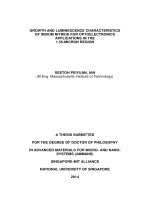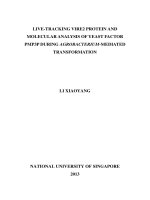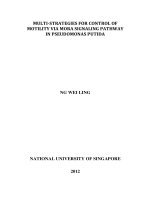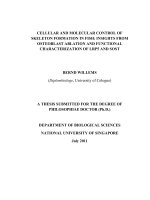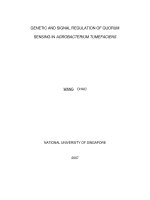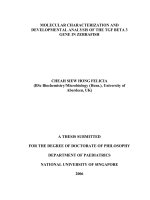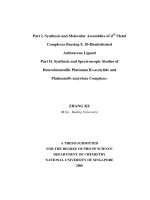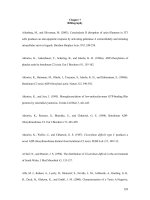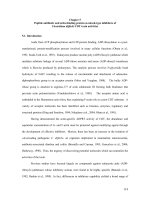Genetic and molecular dissection of DELLA related GA signaling pathway in regulating arabidopsis seed germination
Bạn đang xem bản rút gọn của tài liệu. Xem và tải ngay bản đầy đủ của tài liệu tại đây (2.37 MB, 208 trang )
GENETIC AND MOLECULAR DISSECTION OF DELLA
RELATED GA-SIGNALING PATHWAY IN REGULATING
ARABIDOPSIS SEED GERMINATION
CAO DONGNI
NATIONAL UNIVERSITY OF SINGAPORE
2007
GENETIC AND MOLECULAR DISSECTION OF DELLA
RELATED GA-SIGNALING PATHWAY IN REGULATING
ARABIDOPSIS SEED GERMINATION
CAO DONGNI
(B.SC.)
A THESIS SUBMITTED
FOR THE DEGREE OF DOCTOR OF PHILOSOPHY
INSITUTE OF MOLECULAR AND CELL BIOLOGY
DEPARTMENT OF BIOLOGICAL SCIENCE
NATIONAL UNIVERSITY OF SINGAPORE
2007
i
Acknowledgements
I gratefully acknowledge the Institute of Molecular and Cell Biology (afficiated to
Agency of Science, Technology and Research) for their generous financial support. I
would like to express my deepest gratitude to my supervisor, Associate Professor Peng
Jinrong for his invaluable advice, guidance, encouragement and inspiration through out
this project. I sincerely thank my committee members Associate Professor Yang
Xiaohang, Dr. He Yuehui, Professor Xie Daoxin and Professor Yang Weicai for their
comments and suggestions during my research.
I would like to extend my special thanks to Professor Nicolas N. Harberd for his
invaluable suggestions in my research. My sincere thanks to all the members of the
Functional Genomics Laboratory; Dr. Lee Sor Cheng, Ms. Cheng Hui, Dr. Alamgir
Hussain, Dr. Cheng Wei, Ms Soo Hui Meng, Dr. Chen Jun, Ms Lo Jane, Ms Ruan Hua,
Mr. Huang Honghui, Dr. Guo Lin, Mr. Zhang Zhenhai, Mr. Wu Wei, Mr. Chang
Changqing, Dr. Yang Shulan, Miss Peiying, Ms Evelyn Ng, Mr. Wen Chaoming and Mr.
Gao Chuan for creating a joyful and conducive working environment and rendering me
encouragement, help, discussion and advices.
I would like to thank my friends who are also doing research in different areas, Shi Yaya,
Tang Manli and Ji Liping, for their accompany, encouragement and inspiration during
our PhD studies.
I would like to thank my family members. My parents, my sister and brother have given
me support and understanding. I would like to express my special thanks to my husband
Xu Jin, for his love, patience and unconditional support.
ii
Table of contents
Page
Acknowledgements i
Table of contents ii
Summary x
List of abbreviations xiii
List of tables xiv
List of figures xv
List of publications xvi
Chapter 1 Introduction 1
1.1The importance of GA in regulating plant growth and development 1
1.2 DELLA genes encode a group of negative regulators in GA-signaling
Pathway 1
1.3 The important role of RGL2 in regulating seed germination 5
1.4 Regulation of seed germination by both internal and external regulators 5
1.5 GA promotion of plant development via targeting the negative regulators
DELLAs to degradation via the ubiquitin-proteasome pathway 7
1.6 Aims, values and scope of this work 10
Chapter 2 Literature review 12
Overview of GA and plant development 12
iii
2.1 GA biosynthesis 12
2.1.1 Different forms and metabolism of GA in planta 12
2.1.2 GA biosynthesis in different developmental stages 13
2.1.3 Regulation of GA biosynthesis and catabolism by environmental
cues 14
2.1.4 Regulation of GA biosynthesis by other hormone 15
2.1.5 Feedback and feedforward regulation of GA homeostasis 16
2.2 GA signaling components 17
2.2.1 GA-response mutants 17
2.2.2 Positive regulators of GA signaling 17
2.2.2.1 Soluble GA receptor GID1 17
2.2.2.2 F-box proteins essential for GA signaling pathway 18
2.2.2.3 GTP-binding proteins 18
2.2.2.4 PICKLE (PKL) 19
2.2.2.5 PHOTOPERIOD RESPONSIVE 1 (PHOR1) 19
2.2.2.6 MYB transcription factors 20
2.2.3 Negative regulators of GA signaling 21
2.2.3.1 DELLA genes 21
2.2.3.1.1 Two categories of mutations of GAI gene 21
2.2.3.1.2 GAI and RGA together control stem elongation22
2.2.3.1.3 RGL2 is a key factor in GA-regulated seed
germination 23
iv
2.2.3.1.4 GA regulates floral development by suppressing
the function of RGL1, RGL2 and RGA 23
2.2.3.1.5 “Green Revolution” genes 24
2.2.3.2 SPINDLY (SPY) 24
2.2.3.3 SHORT INTERNODES (SHI) 25
2.2.4 Inhibitor of an inhibitor: GA promote plant development by targeting
DELLA to degradation via the ubiquitin-proteasome pathway 26
2.2.4.1 Structure of DELLA proteins and their degradation 26
2.2.4.2 Degradation of DELLA proteins via the ubiquitin-
proteasome pathway 28
2.2.4.3 Posttranslational modification and degradation 28
2.3 GA signaling and seed germination 31
2.3.1 Seed germination and dormancy 31
2.3.1.1 Dormancy 31
2.3.1.2 Seed germination 31
2.3.1.3 Factors affect seed germination and dormancy 32
2.3.2 GA signaling pathway plays a key role in regulating seed
germination in Arabidopsis 32
Chapter 3 General materials and methods 37
3.1 Plant materials and growth conditions 37
3.2 Genotyping of mutant lines 37
3.3 Germination assays 38
3.4 Scanning electron microscope (SEM) 38
v
3.5 Chemical solutions and growth media 41
3.6 General methods for gene cloning 41
3.6.1 Polymerase chain reaction (PCR) 41
3.6.2 Purification of DNA from agarose gel 42
3.6.3 Isolation of plasmid DNA from E.coli 42
3.6.4 Ligation of DNA fragments into plasmid vectors 42
3.6.5 Transformation of bacteria with plasmids 43
3.6.5.1 Preparation of E.coli competent cells for heat-shock
transformation 43
3.6.5.2 Transformation of E.Coli cells using heat-shock
method 43
3.7 DNA sequencing 44
3.8 Plant genomic DNA extraction 44
3.9 Plant total RNA extraction 44
3.9.1 RNA extraction from seeds 44
3.9.2 RNA extraction from other tissue types 45
3.9.3 RNA extraction from BY2 cells 45
3.8.4 Removal of genomic DNA 45
3.10 Isolation of mRNA from total RNA 46
3.11 Microarray analysis 46
3.11.1 First-cycle, first-strand cDNA synthesis 46
3.11.2 First-cycle, second-strand cDNA synthesis 47
3.11.3 First-cycle, IVT amplification of cRNA 47
vi
3.11.4 First-cycle, cleanup of cRNA 47
3.11.5 Second-cycle, first-strand cDNA synthesis 48
3.11.6 Second-cycle, second-strand cDNA synthesis and
purification 48
3.11.7 Synthesis, purification and quantification of biotin-labeled cRNA
for two-cycle target labeling assays 49
3.11.8 Fragmenting the cRNA for target preparation 49
3.11.9 Target hybridization, washing, staining, and scanning 49
3.12 Ontology analysis and cross-comparing DELLA-dependent
transcriptomes 50
3.13 Probe labeling 51
3.13.1 DNA probes 51
3.13.1.1 PCR amplification 51
3.13.1.2 Probe purification 52
3.13.1.3 Concentration estimation 52
3.13.2 RNA probes 53
3.12.2.1 Template preparation 53
3.13.2.2 In vitro transcription 53
3.14 RT-PCR 54
3.14.1 First strand cDNA synthesis 54
3.14.2 RT-PCR analysis of DELLA transcripts in imbibed seeds 55
3.14.3 RT-PCR confirmation of candidate genes identified from
microarray analysis 55
vii
3.14.4 RT-PCR to assay tissue specific expression of candidate DELLA-
regulated genes 56
3.14.5 RT-PCR to assay expression of GA 20-oxidase in Arabidopsis
leaves 56
3.14.6 RT-PCR to assay expression of GA 20-oxidase in BY2 cells 57
3.15 Virtual northern 57
3.15.1 DNA gel electrophoresis 58
3.15.2 Transfer of DNA from gel to membrane 58
3.15.3 Hybridization 58
3.15.4 Antibody hybridization and detection 58
3.16 Northern blot hybridization 59
3.16.1 Preparation of formaldehyde-denatured RNA gel 59
3.16.2 Sample preparation and electrophoresis 59
3.16.3 RNA transfer from gel to nylon membrane 59
3.16.4 Hybridization 59
Chapter 4 Genetic study of the roles of four DELLA proteins in light- and GA-
regulated seed germination 79
4.1 Introduction 79
4.2 Results 80
4.2.1 RGL2 is the predominant repressor of seed germination in the
light 80
4.2.2 GAI, RGA and RGL1 enhance the function of RGL2 to repress seed
germination 81
viii
4.2.3 RGL2 functions with RGA and GAI to repress seed germination in
the dark 84
4.2.4 Combination of loss-of-function of GAI, RGA, RGL1 and RGL2
leads to both light- and GA-independent seed germination 90
4.2.5 Combination of loss-of-function of GAI, RGA, RGL1 and RGL2
results in embryos with elongated epidermal cells 95
4.3 Discussion 98
Chapter 5 Identification of DELLA-dependent transcriptomes involved in seed
germination 103
5.1 Introduction 103
5.2 Results 105
5.2.1 Identification of DELLA-dependent transcriptomes for seed
germination 105
5.2.2 Ontology analysis of DELLA-dependent transcriptomes for seed
germination 109
5.2.3 DELLAs regulate distinct transcriptomes to control seed germination
and floral development 111
5.2.4 Novel GAMYB genes and other transcription factors 115
5.2.5 DELLAs maintain the low metabolic activity in ga1-3 mutant 117
5.2.6 Distinct approaches are utilized to control cell growth and cell wall
modification during seed germination and floral development 118
5.2.7 DELLAs act as convergence point for phytohormone signaling 118
5.2.8 DELLA-independent or -partially-dependent GA-regulated genes123
ix
5.2.9 Genetic study of candidate DELLA-regulated genes 125
5.3 Discussion 130
Chapter 6 Study of RGL2 stability and activity: conserved serine/threonine residues
are important for GA-sensitivity of RGL2 144
6.1 Introduction 144
6.2 Results 147
6.2.1 RGL2 protein represses GA signaling and is down-regulated by GA
in Arabidopsis 147
6.2.2 Tobacco BY2 cells retain responsiveness to GA 151
6.2.3 RGL2 protein stability and bioactivity can be uncoupled 152
6.3 Discussion 155
Chapter 7 General conclusions and future prospective 158
Reference 161
x
Summary
Gibberellins (GAs) are a group of endogenous growth factors that are essential for a wide
variety of plant developmental processes. Severe GA deficient-mutant ga1-3 which lacks
the important enzyme ent-CDP synthase (ent-copalyl diphosphate synthase) for GA
biosynthesis is non-germinating, dwarf and male sterile. In the past few years, a group of
negative regulators encoded by DELLA genes have been identified. There are five
DELLA genes in Arabidopsis: GAI, RGA, RGL1, RGL2 and RGL3. RGL2 encodes a
repressor of seed germination, loss-of-function mutation of RGL2 partially suppresses the
non-germinating phenotype of ga1-3 in the light, whereas the mutations of other DELLAs
do not.
In this thesis, using ga1-3 mutant as the genetic background, I confirm that RGL2
encodes the predominant repressor of seed germination in Arabidopsis and show that
other DELLA genes GAI, RGA and RGL1 enhance the function of RGL2. More
importantly, I show that ga1-3 seeds lacking RGA, RGL1 and RGL2 or GAI, RGL1 and
RGL2, confer GA-independent germination in the light but not in the dark whilst ga1-3
seeds lacking GAI, RGA and RGL2 germinate both in the light and dark. This suggests
that the destabilization or inactivation of RGA and GAI is not only triggered by GA but
also possibly by light. In addition, ga1-3 seeds lacking in all the aforementioned four
DELLA genes have elongated epidermal cells and confer light-, cold- and GA-
independent seed germination. Therefore, DELLA proteins likely act as integrators of
environmental and endogenous cues to regulate seed germination (Cao et al., 2005).
Besides GA-independent seed germination, the ga1-3 gai-t6 rga-t2 rgl1-1 rgl2-1 mutant
also confers GA-independent floral development. This fact suggests that GA-regulated
xi
transcriptomes for seed germination and floral development are DELLA-dependent.
However, it is currently not known if all GA-regulated genes are GA-regulated in a
DELLA-dependent fashion and if a similar set of DELLA-regulated genes are mobilized
to repress both seed germination and floral development. To address these questions, my
colleagues and I compared the global gene expression patterns in the imbibed seeds and
unopened flower buds of ga1-3 mutant with that of wild type and the ga1-3 gai-t6 rga-t2
rgl1-1 rgl2-1 mutant. We found that approximately half of the total GA-regulated genes
may be regulated in a DELLA-dependent fashion, suggesting that there might be a
DELLA-independent or -partially-dependent component of GA-dependent gene
regulation. A cross-comparison based on gene identity revealed that the GA-regulated
DELLA-dependent transcriptomes in the imbibed seeds and flower buds are distinct from
each other (Cao et al., 2006). To study the relationship of these candidate DELLA-
regulated genes and GA signaling pathway, one way is to dissect the loss-of-function
mutants of such candidate genes. I chose several genes from both the gene set unique for
seed germination and the gene set shared by seed germination and flower development.
The genetic studies of those genes are currently in progress.
Previous studies have shown that GA attenuates the repressive function of DELLA
proteins by triggering their degradation via the proteasome pathway. However, it is not
known if GA-induced protein degradation is the only pathway for regulating the
bioactivity of DELLA proteins. Hussain et al. revealed that several S, T and Y amino
acids are important for the stability of RGL2 proteins in transgenic BY2 cells (Hussain et
al., 2005). By examining the expression of GA20 oxidase, the marker gene of DELLA-
regulated GA signaling pathway, I further investigated the bioactivity of these stabilized
xii
mutant proteins (Hussain et al., 2005). My results suggest that the stabilization and
bioactivity of RGL2 protein can be uncoupled and protein degradation is not the only
pathway for regulating RGL2’s bioactivity.
xiii
List of abbreviations
ABA 2-cis-4-trans-abscisic acid
CTAB hexadecyl trimenthyl-ammonium bromide
DEPC diethyl-pyrocarbonate
DIG digoxigenin
E.coli Escherichia coli
ent-CDP ent-copalyl diphosphate
GA Gibberellic Acid
GC-MS Gas Chromatograph - Mass Spectrometer
IPTG isopropylthio-β-D-galactoside
IVT in vitro transcription
LB Lubria bertani
ORF open reading frame
PAC paclobutrazol
PCR polymerase chain reaction
SEM scanning electron microscope
SDS sodium dodecylsulphate
SSC standard saline citrate
Tris tris(hydroymethyl)-ammminomethane
d day
h hour
min minute
s second
xiv
List of tables
Page
Table 3.1 Primers used for genotyping 60
Table 3.2 Primers used for RT-PCR detecting DELLA transcripts in seeds 62
Table 3.3 Primers used for RT-PCR of genes encoding GA20 oxidase 63
Table 3.4 Primers used for RT-PCR confirmation of DELLA-down genes in
imbibed seeds identified by microarray analysis.
64
Table 3.5 Primers used for RT-PCR confirmation of DELLA-up genes in
imbibed seeds identified by microarray analysis
69
Table 3.6 Primers used for confirmation of DELLA-down genes both in imbibed
seeds and young flower buds identified by microarray analysis
72
Table 3.7 Primers used for confirmation of DELLA-up genes both in imbibed
seeds and young flower buds identified by microarray analysis
74
Table 3.8 Primer pairs used for genotyping SALK T-DNA insertion lines 76
Table 3.9 Primer pairs used for RT-PCR of candidate DELLA-regulated genes 78
Table 5.1 Summary of GA- and DELLA-regulated transcriptomes 132
Table 5.2 Ontology analysis of DELLA-regulated genes based on molecular
function assigned
133
Table 5.3 Cross-comparison of genes related to some important biochemical and
biological processes in imbibed seeds and unopened young flower buds
134
Table 5.4 DELLA-regulated genes involved in both flower initiation and seed
germination
140
Table 5.5 GDSL-type lipase genes regulated by DELLAs 142
Table 5.6 Candidate genes selected for further study and the insertion lines
isolated
143
xv
List of figures
Page
Figure 1.1 GA promotes plant growth by repressing the function of
negative regulators, DELLA proteins
3
Figure 1.2 A model for the GA signaling pathway in Arabidopsis. 8
Figure 2.1 Structure of DELLA proteins. 29
Figure 2.2 Three stages of imbibition 33
Figure 3.1 Schematic diagram showing the Ds-insertion sites in the gai-t6,
rga-t2, rgl1-1 and rgl2-1, and the primers used for genotyping
39
Figure 4.1 Analysis of germination capacity of ga1-3 seeds (dry stored for
three months) lacking of individual DELLA proteins.
82
Figure 4.2 Analysis of germination capacity of ga1-3 seeds (dry stored for
5 months) lacking of pair-wise combinations of DELLA proteins.
85
Figure 4.3 Analysis of germination capacity of ga1-3 seeds (dry stored for
5 months) lacking of three-way combinations of DELLA proteins.
88
Figure 4.4 Light has minimum effect on the transcript levels of DELLA
genes.
91
Figure 4.5 Combination of loss-of-function of RGL2, RGA, GAI and RGL1
leads to both light- and GA-independent seed germination
93
Figure 4.6 Combination of loss-of-function of RGL2, RGA, GAI and RGL1
promotes the elongation growth of the epidermal cells
96
Figure 5.1 RT-PCR confirmation of DELLA-down and DELLA-up genes
in the imbibed seeds
107
Figure 5.2 RT-PCR confirmation of shared DELLA-down and DELLA-up
genes in the imbibed seeds and young flower buds
113
Figure 5.3 Amino acid sequence alignment of rice GID1 with its three
Arabidopsis homologues (At3g05120, At3g63010, At5g27320) using
ClustalW program
120
Figure 5.4 Amino acid sequence alignment of 13 GDSL-type lipase in
Arabidopsis using ClustalW program.
121
Figure 5.5 RT-PCR of candidate DELLA-regulated genes in different plant
tissues
126
Figure 5.6 RNA gel-blot hybridizations using DIG-labeled AtMYC3 and
AtMYC2 probe and total RNA from inflorescences
127
Figure 6.1 RGL2 is a GA-derepressible negative regulator of response to
GA in both Arabidopsis and the tobacco BY2 cell line.
149
Figure 6.2 Uncoupling of RGL2 stability and its bioactivity in response to
GA treatment
153
xvi
List of publications
1. Hussain A, Cao D, Peng J. Identification of conserved tyrosine residues
important for gibberellin sensitivity of Arabidopsis RGL2 protein.
Planta. 2007 Jul;226(2):475-83.
2. Cao D, Cheng H, Wu W, Soo HM, Peng J. Gibberellin mobilizes distinct
DELLA-dependent transcriptomes to regulate seed germination and floral
development in Arabidopsis. Plant Physiol. 2006 Oct;142(2):509-25.
3. Hussain A, Cao D, Cheng H, Wen Z, Peng J. Identification of the conserved
serine/threonine residues important for gibberellin-sensitivity of Arabidopsis
RGL2 protein. Plant J. 2005 Oct;44(1):88-99.
4. Cao D, Hussain A, Cheng H, Peng J. Loss of function of four DELLA genes
leads to light- and gibberellin-independent seed germination in Arabidopsis.
Planta. 2005 Dec;223(1):105-13.
5. Cheng H, Qin L, Lee S, Fu X, Richards DE, Cao D, Luo D, Harberd NP, Peng J.
Gibberellin regulates Arabidopsis floral development via suppression of DELLA
protein function. Development. 2004 Mar;131(5):1055-64.
1
Chapter 1 Introduction
1.1 The importance of GA in regulating plant growth and development
Gibberellins (GAs) are a group of endogenous tetracyclic diterpinoid growth factors that
are essential for a wide variety of plant developmental processes, including seed
germination, stem elongation, leaf expansion, trichome development, and flower and fruit
development (Hooley, 1994). Although more than a hundred of GAs have been identified,
only a few of them are known to be biologically active. The importance of GA for plant
growth and development in Arabidopsis has been demonstrated by the fact that severe
GA deficient-mutant, such as ga1-3 which lacks the important enzyme ent-CDP synthase
(ent-copalyl diphosphate synthase) for GA biosynthesis (Sun and Kamiya, 1994), is non-
germinating, dwarf and male sterile (Koornneef and van der Veen, 1980; Cheng et al.,
2004).
GA studies include four aspects: GA biosynthesis, GA perception, GA signaling and GA
response. In recent years, besides vast progresses made in studying of GA-biosynthesis
and GA perception (please refer to Chapter 2 for details), a lot of breakthroughs have also
been made on GA-signaling pathway, such as the discovery of DELLA genes.
1.2 DELLA genes encode a group of negative regulators in GA-signaling pathway
In the past decade, many genes responsible for GA perception and GA signaling
transduction have been identified, including a group of negative regulators encoded by
DELLA genes (Peng et al., 1997; Silverstone et al., 1998; Richards et al., 2001). DELLA
proteins (DELLAs) form a subfamily of GRAS family of putative transcription factors
which appear to be unique to plants (Peng et al., 1999a; Pysh et al., 1999; Richards et al.,
2
2000). There are ~30 candidate GRAS ORFs in Arabidopsis genome. The GRAS proteins
share high homology in their C-terminal regions which contain features with
characteristics of transcription factors and an SH2-like domain. On the contrary, the N-
terminal regions of GRAS proteins are highly diversified. DELLAs were classified as a
subfamily because they also share high homology in the N-terminal regions (Lee et al.,
2002).
There are five DELLA genes in Arabidopsis: GAI, RGA, RGL1, RGL2 and RGL3 (Figure
1.1) (Peng et al., 1999a; Richards et al., 2000; Dill and Sun, 2001; Lee et al., 2002; Wen
and Chang, 2002). The roles of some of DELLAs have been investigated in several
studies by observing how the loss-of-function mutations of DELLA genes suppress the
phenotype of GA-deficient mutants. In Arabidopsis, GAI and RGA are coupled to act as
GA-repressible repressors of stem elongation because the combination of loss-of-function
of GAI and RGA, gai-t6 and rga-24 completely suppresses the dwarf phenotype conferred
by the ga1-3 mutation (Peng et al., 1997; Silverstone et al., 1998; Dill and Sun, 2001;
King et al., 2001). As for floral development, together loss-of-function of RGA, RGL1
and RGL2 completely suppresses the male sterile phenotype conferred by ga1-3 mutant,
suggesting that these three genes synergistically repress floral development (Cheng et al.,
2004; Yu et al., 2004; Tyler et al., 2004). These extensive studies revealed the roles of
DELLA genes in GA-mediated plant growth by genetic approaches. However, these
studies all focused on the physiological roles of DELLAs. As a group of transcription
regulators, the downstream genes of DELLAs have never been systematically
investigated.
3
Figure 1.1
Seed Germination
RGL2
Other DELLAs?
GAI and RGA
RGA,RGL1
and RGL2
Gibberellin
Flower
Development
Stem Elon
g
ation
4
Figure 1.1 GA promotes plant growth by repressing the function of negative regulators,
DELLA proteins. GAI and RGA together control stem elongation. RGA, RGL1 and
RGL2 work synergistically to repress flower development. RGL2 has been demonstrated
to be related with seed germination, but whether other DELLAs are also involved in seed
germination is unclear before this study.
5
1.3 The important role of RGL2 in regulating seed germination
Besides regulating floral initiation, RGL2 has also been proven to encode a key repressor
of seed germination. Lee et al. found that the germination of RGL2 Ds-insertion knockout
mutant alleles, rgl2-1, rgl2-5 and rgl2-12, is strongly resistant to paclobutrazol (PAC),
which can inhibit germination by inhibiting GA biosynthesis. In addition, rgl2-1 and
rgl2-12 partially suppressed the non-germination phenotype of ga1-3 without affecting
the stem and floral abnormity. More importantly, the mRNA levels of RGL2 in ga1-3
seeds were found to be induced by imbibition and down-regulated by GA treatment (Lee
et al., 2002). Since the interaction between GA-signaling system and environmental
signals has been an important topic of research in recent years, Lee et al. provides a
significant discovery for the study of interaction between environmental cues and plant
development regulation. However, the germination capacity of ga1-3 rgl2-1 double
mutant seed is not as good as that of the wild type seed, especially in the dark. It remains
unclear whether other negative regulators of seed germination exist. Since other plant
development events, like stem elongation and flower development, are regulated by
different combinations of DELLA genes, it is reasonable to speculate that seed
germination is also regulated by the combination of RGL2 and other DELLAs.
Surprisingly, Arrizumi and Steber found that in GA-insensitive sly1 mutant, RGL2
accumulated at high levels even in seeds with 100% germination rates. However, this
result does not mean RGL2 is not important in repressing seed germination. It is possible
that the RGL2 protein is inactivated by after-ripening of sly1 mutant seeds (Arrizumi and
Steber, 2007).
1.4 Regulation of seed germination by both internal and external regulators
6
Seed germination incorporates processes that commence with the uptake of water by the
quiescent dry seed and terminate with the elongation of the embryonic axis (Bewley and
Black, 1994; Bewley, 1997). Seed dormancy is defined as the failure of an intact viable
seed to complete germination under favorable conditions (Lang, 1996). The transition of
a seed from dormancy to germination is controlled by external environmental cues
(including light, moisture, and transient exposure to cold), and by the internal growth
regulators gibberellin (GA) and abscisic acid (ABA). ABA establishes and maintains
dormancy, whereas GA induces germination (Koornneef and Karssen,
1994; McCarty,
1995; Bewley, 1997; Steber et al., 1998; Peng and Harberd, 2002). The importance of
GA in promoting germination is well demonstrated by the observation that the GA-
deficient mutant ga1-3 is non-germinating (Koorneef and van der Veen, 1980).
Furthermore, GA biosynthesis inhibitors like PAC and uniconazol can inhibit
germination, which proves that newly synthesized GAs are required after imbibition for
radical emergence (Nambara et al., 1991; Jacobsen and Olszewski, 1993).
Light is one of the most important external factors that induce seed germination in many
plant species, including Arabidopsis (reviewed by Casal and Sanchez, 1998). In
Arabidopsis, light signaling is mediated by a group of phytochromes, from PHYA to
PHYE. Previous reports have shown that the absence of PHYA, PHYB and PHYE
reduced the germination capability of Arabidopsis seeds (Shimomura et al., 1994, 1996;
Hennig et al., 2002), implying that phytochromes positively regulate seed germination.
Yamaguchi et al. revealed that light induces the de novo biosynthesis of bioactive GA by
promoting the expression of GA synthesis genes AtGA3ox1 and AtGA3ox2 in imbibing
seeds. This indicates that light promotes germination, at least in part, by inducing the
7
biosynthesis of internal factor GA (Yamaguchi et al., 1998). However, Lee et al.
demonstrated that although ga1-3 rgl2-1 double mutant seed is highly deficient in GA-
biosynthesis, it still reacts to light regarding seed germination. This indicates that, besides
promoting GA biosynthesis, light probably affects seed germination directly through GA-
signaling pathway. Recently, a phytochrome-interacting protein PIL5 has been identified
as a negative regulator of seed germination in Arabidopsis (Oh et al., 2004). Oh et al.
showed that PIL5 might affect GA biosynthesis as well as the transcription of GA
signaling mediators, RGA and GAI (Oh et al., 2007).
1.5 GA promotion of plant development via targeting the negative regulators
DELLAs to degradation via the ubiquitin-proteasome pathway
Besides the physiological roles of GA signaling in regulating plant growth, the molecular
mechanism of GA actions has also been intensively studied in recent years (Figure 1.2).
In brief, the binding of GA to its soluble receptor GIBBERELLIN INSENSITIVE
DWARF 1 (GID1) or -like (Ueguchi-Tanaka et al., 2005; Hartweck and Olszewski, 2006)
triggers the degradation of plant growth repressor DELLAs via the 26S proteasome
pathway (Silverstone et al., 2001; Itoh et al., 2002; Fu et al., 2002; Hussain et al., 2005).
The degradation process is mediated by GA-specific F-box proteins GID2 (Sasaki et al.,
2003) and SLY1 (McGinnis et al., 2003; Dill et al., 2004; Fu et al., 2004). The
degradation of DELLAs releases plant from the DELLA-mediated growth restraint
(Harberd, 2003). It has been shown that the GA-induced degradation of barley SLN1 is
sensitive to serine/threonine protein phosphatase inhibitors (Fu et al., 2002), but there is
no evidence to show whether SLN1 is phosphorylated. In rice, the phosphorylated form
of SLR1 was elevated in a gid2 mutant. Furthermore, the level of phosphorylated form of
